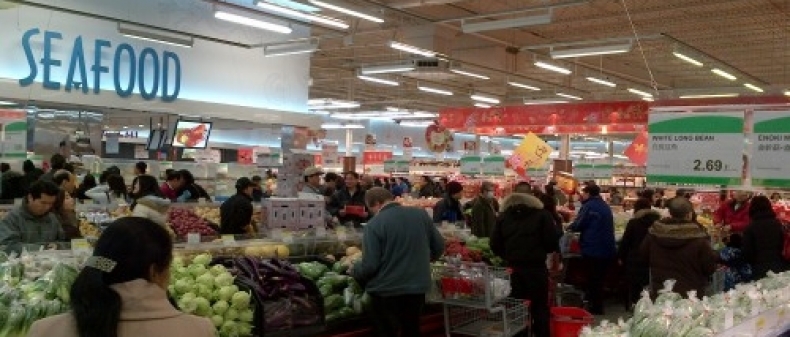
Over the weekend, I made my first trip to the much fussed-about Loblaws at the Maple Leaf Gardens. I like grocery shopping for people-watching and I worried that, only weeks after opening, Toronto would have bored of the shiny new store and I’d be depressingly wandering a ghost town. Happily, my fears proved to be unfounded: the spot was bouncing with Saturday afternoon shoppers, a pleasant juxtaposition to the building’s decade of emptiness (save the occasional film shoot). The store’s heavily publicized nods to the past–the old-timey marquee, the Maple Leafs sculpture assembled from old arena seats and the mark on the ground indicating centre ice–give it a slight tourist feel and, fittingly, some people were taking photos of themselves against a hockey mural by the checkout.
As for the food, the store didn’t stretch too far from conventional stores, given that it was mostly stocked with house brand President’s Choice foods–that blandly aspirational series of processed foods. There were a few nice flourishes, like the availability of bulk dried mushrooms and the wall (more a large cabinet) of cheese.
But what really caught my eye was the pineapple bun.
The pineapple bun is a contemporary Chinese pastry that, funnily enough, contains no pineapple. Instead, the name derives from the sweet, crusted top, which resembles the skin of the pineapple. The pineapple bun is usually found in the Chinese bakery and supermarket, so finding one in a former hockey haven threw me. The bun wasn’t alone: the Maple Leaf Gardens location has a full roster of Asian foods integrated throughout, which is surprising given that it’s located in an area of Toronto not especially known for an Asian population. Beyond the standard servings of boxed sushi and frozen dumplings, there was a fresh assortment of Asian vegetables, sauces other than soy and an assortment of Chinese baked goods. Where these foods would have once been relegated to the ethnic aisle (or not even been available), they now they sit beside Western staples in the flagship store of a massive Canadian grocery chain–upon reflection, I was reminded of the old adage “you are what you eat.”
Loblaws and other grocery chains–including Sobeys, Longo’s and Metro–have been slow to reflect Canada’s shifting demographics in the products it sells, allowing a cottage industry of smaller Asian supermarkets to pop up and sell durians, atta flour and kimchi. In a bid to grab part of the market, Loblaw (parent company to Loblaws–it’s confusing, I know) purchased Asian supermarket chain T&T, one of the biggest players of the start-ups, in 2009. The T&T name has become integrated into the company as a new house brand for Asian foods. The partnership has been a good one financially for Loblaw: by the corporation’s own record, T&T contributed largely to a profit boost of 26% in its first quarter of 2010 and the majority of a 3% climb in revenue.
In addition to diversifying the foods in Loblaws stores, a rapid expansion of the standalone T&T stores continues in suburban cities with large Asian populations: by the end of the year, Markham will have three T&T stores, with one having opened just after the new year. (The closest T&T to the downtown core is at the Port Lands, where a Knob Hill Farms used to exist.) I visited the new T&T on its opening weekend, and the store was packed with customers. Reportedly, police had to direct traffic in the parking lot in the first few days–who could have imagined such a pent up excitement for a grocery store?
What accounts for the crowds? The key may come from an observation Lisa Miller made in a Newsweek article on how food speaks to class in America, she notes that “what you eat for dinner has become the definitive marker of social status.” In Canada, it is no different. And to have an Asian supermarket–the place where so many go to get what they want to eat for dinner–as a meaningful part of a Canadian food giant is important and relevant. It bursts open the Anglo-normative view of Canadian society and creates a fairer representation of the society as a whole.
This takes me back to the pineapple bun. The pastry’s place in the Maple Leaf Gardens Loblaws indicates a two-way flow between T&T and its new parent company. You may suggest that I am placing too much significance on a pastry and you might be right. Still, although there are closer places to shop for groceries, I will visit Maple Leaf Gardens to check in on the state of the pineapple bun. I’m interested to see if, in a year’s time, whether this species will survive or go extinct. At least if it disappears, it won’t be because of quality: Loblaws’ bun isn’t soft enough and could be sweeter, but it gets pretty darn close. For what it’s worth, they soundly thump the croissants.











